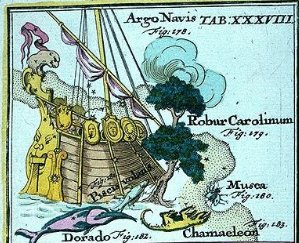15. Yet, Manuscript E is explicit; the explorers reached Hanga Hoonu in July 18, not in February. By our rule of thumb it is easy to find July 18 in the G text, we have only to subtract 144 from the day number (199):
Heap of Fuel and Bright Fire are star names which may have been known by the creators of Manuscript E. The idea to go back to the boat for fire seems to be related to my idea of Naos as a kind of temple:
There are no signs of the profusion of fishes, but Sign language is probably characterized by the principle of pars pro toto - only some of the relevant signs characterizing an event are picked out in a manner which makes a nice picture. And, it can be argued, the explorers went out into the water to fetch the fishes with their hands in order to throw them up onto land. To have fishes beyond the beginning of the henua (land) calendar would be misleading. The fishes are in the G picture connected with the culmination of the Crux (Candle) stars and it should be night. The henua calendar is beginning with the heliacal rising of Naos, at the end of the sunken Sun ship (as it is viewed from a position north of the equator). It has stranded on Easter Island, with stern first of course: ... Sternforward Argō by the Great Dog's tail // Is drawn; for hers is not a usual course, // But backward turned she comes, as vessels do // When sailors have transposed the crooked stern // On entering harbour; all the ship reverse, // And gliding backward on the beach it grounds. // Sternforward thus is Jason's Argō drawn. (Cfr at Ana-muri).
A curious Sign in Manuscript E should now be mentioned. The manuscript has 110 pages with the last 10 obviously constituting a special group because beyond page 100 there are 10 pages labelled Tori 1 - Tori 10. Among the main 100 pages those labelled 25 and 26 are exceptional - the lower third of these pages are cut off:
100 + 10 - 2 = 108. And 108 - ⅓ - ⅓ - ⅓ = 107. I guess manu kake in Ga3-1 and July 24 could coincide with page 24 in Manuscript E:
Page 26 of the manuscript is where the explorers have left Hanga Hoonu and reached Rangi Meamea, 'on the twenty-third day of the month of Anakena'. I think we cannot translate the Anakena month mechanically to July, possibly it is beginning with July 3 (day 184 and 12 days after the solstice). ... The Rapa Nui calendar begins with the month of Anakena (the name of the landing site of Hotu Matu'a). Anakena was said by Thomson to mean August, but Métraux corrected that to July ... The missing lower thirds of pages 25-26 could mean 'water no longer present'. A tripartite cosmos with sky at the top, earth in the middle, and sea at bottom is basic to human culture. With the arrival of the henua calendar the canoe will be left behind, another sign of how the sea journey in the sky is in the past. Page 24 in the manuscript has the word kake referring to the great number of fishes nearly up on land:
... ξ [at Ga3-15], another [ín addition to μ, Heap of Fuel at Ga2-28] 5½-magnitude, with λ Leonis, formed the seventh manzil Al Tarf, the End, or as some translate it, the Glance, i.e. of the Lion's Eye, the ancient Asad, which occupied so large a portion of the sky in this neighborhood. They also were the Persian Nahn, the Nose, and the Coptic Piautos, the Eye, both lunar asterisms. |
||||||||||||||||||||||||||||||||||||||||||||||||||||||||||||||||||||||||||||||||||||||||||||||||||||||||||




